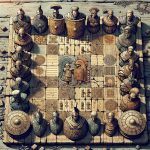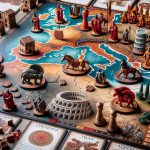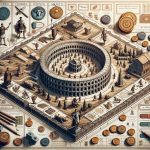Roman strategy board games have a rich history dating back to ancient times, providing insight into the strategic minds of the Roman people. These games were not just for entertainment but also served as tools to hone military tactics and decision-making skills. In this article, we will delve into the origins, types, rules, and historical significance of Roman strategy board games, shedding light on their enduring appeal and legacy.
The origins of Roman strategy board games can be traced back to various civilizations that influenced Roman culture, including the Greeks and Egyptians. These ancient games were more than just pastimes; they were essential in developing critical thinking and strategic planning skills. As we explore the roots of these games, we gain a deeper understanding of how they played a crucial role in shaping the minds of the ancient Romans.
From popular games like ludus latrunculorum (latrunculi) to tabula (tabula lusoria), Roman strategy board games offered a diverse array of challenges for players. Each game required different skills and strategies, making them not only enjoyable but also intellectually stimulating. By examining the types of Roman strategy board games played during that era, we can appreciate the complexity and depth of these ancient pastimes.
Origins of Roman Strategy Board Games
Roman strategy board games have a rich history that dates back to ancient times, offering insights into the strategic thinking and recreational activities of the Romans. These games were not only sources of entertainment but also tools for teaching military tactics and decision-making skills. The origins of Roman strategy board games can be traced back to various civilizations that influenced Roman culture and gameplay.
Some of the earliest known Roman strategy board games were influenced by the Greeks, Etruscans, and other neighboring civilizations. These games evolved over time, incorporating different elements from each culture to create unique gaming experiences. One of the most famous Roman strategy board games is Ludus Latrunculorum, which translates to “Game of Mercenaries” or “Game of Thieves.” This game involved strategic movement and capture mechanics similar to modern-day chess.
To gain a deeper understanding of the origins of Roman strategy board games, it is essential to explore the materials and methods used in creating these ancient pastimes. Many of these games were played on boards made from simple materials like wood or stone, with pieces crafted from bone, ivory, or clay. The intricate designs and patterns found on surviving game boards provide valuable insights into the artistic skills and craftsmanship of the Romans in creating their entertainment sources.
Overall, studying the origins of Roman strategy board games sheds light on the cultural exchanges and influences that shaped ancient gameplay. From traditional Greek strategies to innovative Roman advancements, these ancient games continue to intrigue scholars and enthusiasts alike with their historical significance and enduring appeal. By delving into the roots of these timeless pastimes, we can appreciate the creativity and ingenuity of our ancestors in developing strategic challenges that captivated players for generations.
- Some key points:
- Influence from neighboring civilizations
- Evolution over time
- Materials used in creating game boards
Types of Roman Strategy Board Games
Roman strategy board games were a popular pastime in ancient Rome, offering entertainment and mental stimulation to people of all ages. These games were not only played for leisure but also served as a tool for teaching military tactics and strategic thinking. Let’s delve into the different types of Roman strategy board games that were enjoyed by the citizens of Rome:
- Ludus Latrunculorum: Also known as “the Game of Mercenaries,” Ludus Latrunculorum was a strategic game similar to chess or checkers. Players moved their pieces around the board, capturing their opponent’s pieces by surrounding them on two opposite sides. The goal of the game was to capture all of your opponent’s pieces or to block them so they couldn’t make any moves.
- Duodecim Scripta: This game involved dice and skillful movement of pawns on a board with 12 markings. Players had to race their pawns around the board, bearing them off at the end while trying to block their opponent from doing the same. Duodecim Scripta required both luck with the dice and strategic planning to outmaneuver your opponent.
- Tabula: Tabula was similar to modern-day backgammon, involving dice rolls and strategic movement of pieces across a board with 24 points. The objective was to move all your pieces off the board before your opponent while strategically blocking their progress. Tabula was a game that combined luck and skill, making it a favorite among Roman gamblers.
These games provided not only entertainment but also helped develop critical thinking skills and strategic planning abilities in those who played them. The intricacies of each game required players to anticipate their opponent’s moves while plotting their own strategies for victory. As Roman society valued discipline, order, and military prowess, these strategy board games reflected those values and offered a fun way for individuals to hone their tactical skills.
Game Rules and Gameplay
Roman strategy board games played a significant role in the ancient Roman society, offering not just entertainment but also valuable lessons in military tactics and decision-making. These games were not just about luck, but required strategic planning, critical thinking, and foresight to outmaneuver opponents and emerge victorious. Understanding the rules and gameplay of these games provides insights into the strategic mindset of the Romans.
Types of Roman Strategy Board Games
One of the most popular Roman strategy board games was Ludus Latrunculorum, also known as “The Game of Mercenaries.” This game involved two players moving pieces around a grid-like board, capturing each other’s pieces by surrounding them. Another well-known game was Ludus Duodecim Scriptorum, a precursor to backgammon, where players raced their pieces around a board while strategically blocking their opponent’s progress.
Gameplay and Strategies
In Roman strategy board games, each piece had specific movement capabilities and objectives, requiring players to plan their moves carefully. Players had to anticipate their opponent’s movements while also advancing toward their own victory conditions. The ability to adapt strategies on-the-fly and make calculated risks were crucial skills for success in these games.
Historical Significance
Beyond mere entertainment, Roman strategy board games served as valuable tools for teaching military tactics and fostering strategic thinking among individuals. Military leaders often used these games to simulate battle scenarios, test different strategies, and hone their decision-making skills. By understanding the rules and gameplay of these ancient games, we gain a deeper appreciation for how they influenced not only recreational activities but also military training in ancient Rome.
Historical Significance
Roman strategy board games held significant importance in ancient Rome beyond just entertainment. These games were often used as tools to teach military tactics and decision-making skills to soldiers and commanders. One of the most popular Roman strategy board games, Ludus Latrunculorum, also known as “The Game of Mercenaries,” was particularly instrumental in honing strategic thinking on the battlefield.
Players of Ludus Latrunculorum had to carefully plan their moves and anticipate their opponent’s strategies, much like a military leader making decisions during a battle. The game involved capturing opponents’ pieces by surrounding them with your own pieces, requiring foresight and planning to outmaneuver the enemy. This aspect made Ludus Latrunculorum not only entertaining but also a valuable training tool for Roman soldiers.
In addition to developing tactical skills, Roman strategy board games helped cultivate decision-making abilities among players. By facing difficult choices and consequences within the confines of a game, individuals could learn how to weigh risks, assess situations, and make sound judgments under pressure. This practical application of critical thinking in a recreational setting contributed to the overall success of Roman military campaigns, making these board games more than just pastimes-they were essential tools for training competent leaders.
Modern Adaptations
Roman Influence on Modern Games
One of the most notable ways in which Roman strategy board games have influenced modern gaming is through their emphasis on tactics and planning. Many contemporary board games, such as “Risk” and “Axis & Allies,” draw inspiration from the military strategies employed by the Romans, challenging players to outthink and outmaneuver their opponents in order to achieve victory.
Rediscovering Lost Games
In addition to inspiring new creations, modern adaptations of Roman strategy board games often strive to accurately recreate lost or forgotten games from antiquity. By studying historical texts and archaeological findings, game designers are able to resurrect these ancient pastimes for a new generation, offering players a glimpse into the mindset and skillset of Roman strategists.
From physical tabletop games to digital adaptations available on various platforms, the enduring legacy of Roman strategy board games continues to captivate audiences around the world. As technology advances and historical research deepens, we can expect even more innovative interpretations of these ancient games to emerge, ensuring that their influence endures for generations to come.
Fun Facts
This strategic game involved capturing opponents’ pieces while protecting your own, requiring complex tactics and forward planning. The game was not only a form of entertainment but also served as a way for soldiers to practice military strategies during their downtime.
Another intriguing fact about Roman strategy board games is that many of them were not just played for leisure, but also had educational purposes. Games like Ludus Duodecim Scriptorum, a precursor to Backgammon, were used to teach counting and improve mathematical skills among players. Additionally, these board games were instrumental in teaching individuals important military strategies and decision-making skills, making them valuable tools for both education and entertainment.
One lesser-known aspect of Roman strategy board games is their role in social gatherings and networking. Wealthy Romans often hosted extravagant game nights where guests would compete in various board games while discussing politics, philosophy, and other intellectual topics. These gatherings served as important social events where relationships were formed and alliances were strengthened, showcasing the significance of these games beyond just playful competition.
| Interesting Fact | Description |
|---|---|
| Ludus Latrunculorum | A strategic game involving capturing opponents’ pieces. |
| Educational Purpose | Many Roman board games served to educate players in various skills. |
| Social Gatherings | Wealthy Romans hosted game nights as important social events. |
Conclusion
In conclusion, Roman strategy board games hold a timeless appeal that continues to captivate and inspire players even in modern times. These ancient games are not just sources of entertainment but also valuable tools for teaching military tactics, decision-making, and strategic thinking. The enduring legacy of Roman strategy board games is evident in the way they have influenced and shaped the development of modern board games.
From the origins of games like Ludus Latrunculorum and Tabula to the intricate rules and gameplay mechanics, Roman strategy board games offer a glimpse into the strategic mindset of one of history’s greatest civilizations. The importance placed on skillful planning, adaptability, and resource management in these games reflects the military strategies employed by the Romans during their conquests.
As we reflect on the historical significance and cultural impact of Roman strategy board games, it is clear that these ancient pastimes have left a lasting impression on the world of gaming. Whether it’s recreating battles on a virtual battlefield or engaging in strategic warfare on a game board, the influence of Roman strategy board games can still be seen today.
So next time you gather around a table to play your favorite board game, remember that you are carrying on a tradition that dates back centuries to the tactical minds of ancient Rome.
Frequently Asked Questions
What Was the Most Popular Roman Board Game?
The most popular Roman board game was Ludus Latrunculorum, also known as Latrunculi or simply as the Game of Mercenaries. It was a strategic game involving capturing opponents’ pieces by surrounding them with your own.
What Is the Most Famous Strategy Board Game?
The most famous strategy board game is undoubtedly Chess. Originating in India around the 6th century AD, Chess has evolved into a global game that requires immense skill, tactics, and foresight to outsmart opponents.
What Is the Oldest Strategy Board Game?
The oldest strategy board game is believed to be Senet, an ancient Egyptian game dating back to around 3100 BC. Senet involved moving pieces along a board of varying sizes and shapes, representing different stages of life and challenges to overcome.

I love playing all kinds of games – from classics like Monopoly to modern favourites like Ticket to Ride.
I created this blog as a way to share my love of board games with others, and provide information on the latest releases and news in the industry.





